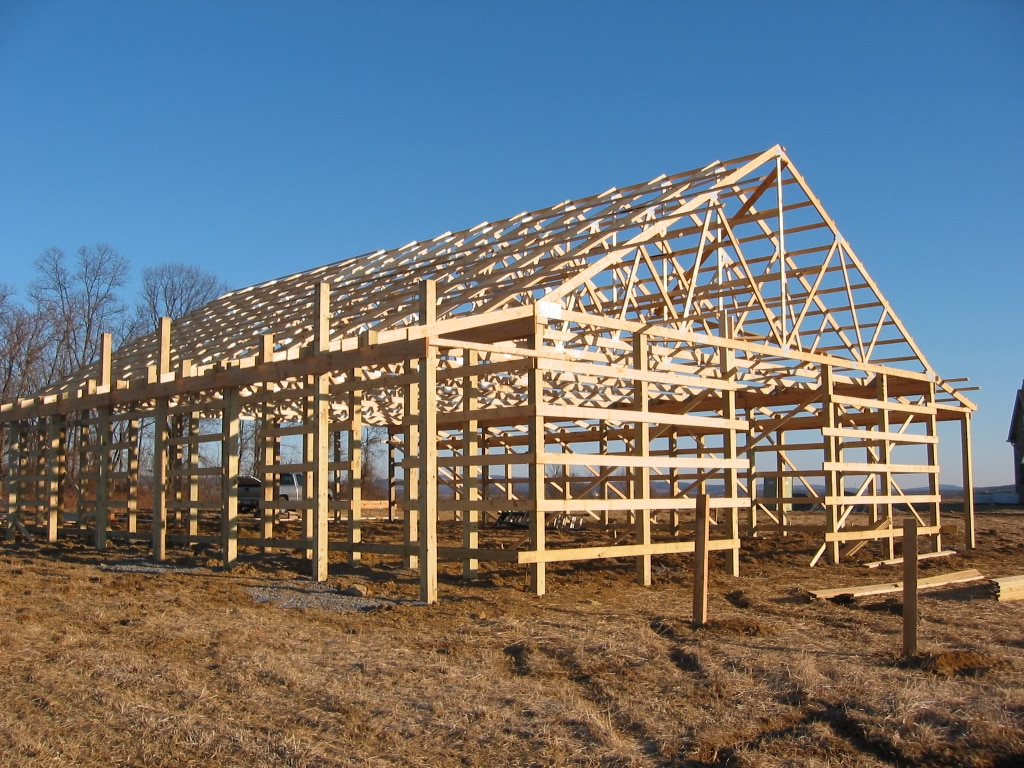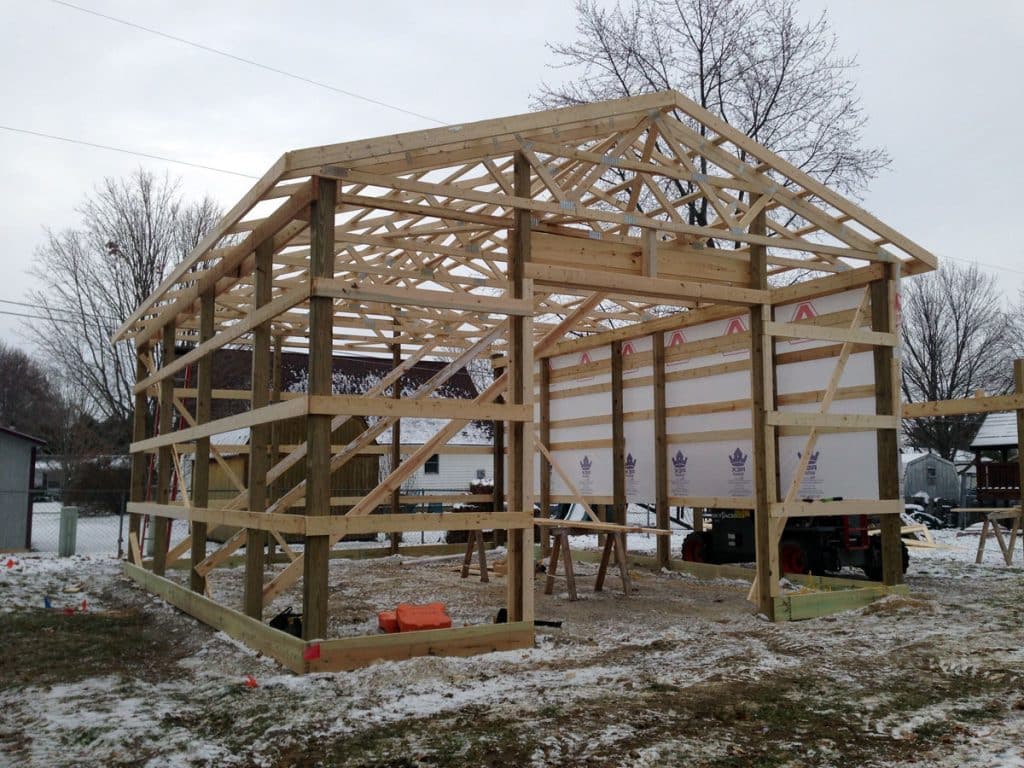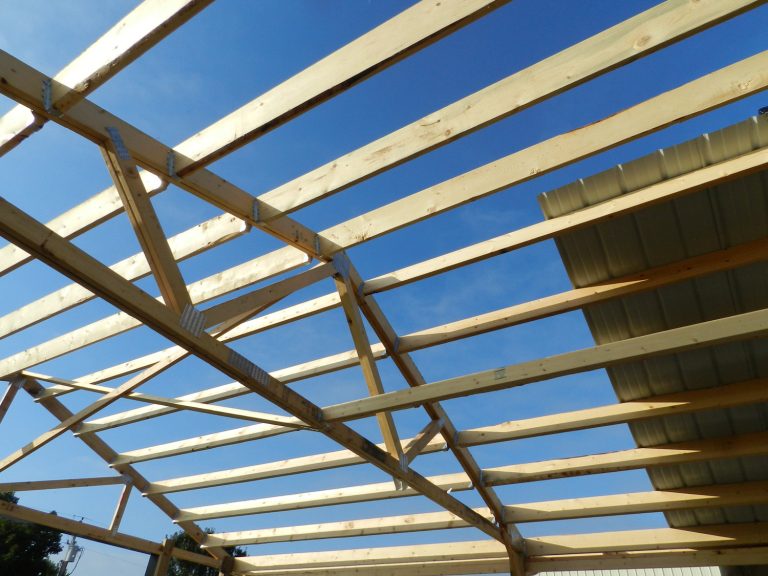Roof trusses are an essential component of any pole barn, providing the necessary structural support and strength. Engineered trusses are designed to offer increased strength, longer life, and a higher quality than traditional wood frame trusses. This allows for a more reliable and long-lasting pole barn structure.
Engineered pole barn trusses are composed of several key elements, including the top and bottom chords and the webs. The top chord, typically made of wood or steel, supports the roof’s weight while the bottom chord, generally made of wood, provides horizontal support to the truss. The webs connect the chords and transfer the loads to the supporting columns or posts.
There are a variety of truss configurations available to suit different pole barn requirements. These options include:
- King Post Truss: This simple design features a single vertical web, providing the most basic support for smaller pole barns.
- Queen Post Truss: A more robust option than the king post truss, this design includes two vertical webs, offering greater structural support for larger pole barns.
- Parallel Chord Truss: This option features two parallel chords, with the webs arranged diagonally between them. It allows for a versatile design suitable for a wide range of pole barn applications.
- Gambrel Truss: A double-sloped design, the gambrel truss provides more headroom in the center of the pole barn, making it ideal for maximizing usable space.
- Scissor Truss: This design features sloping bottom chords, creating a vaulted ceiling within the pole barn for a more aesthetically pleasing appearance.
Each of these truss options offers different advantages in terms of strength, structure, and aesthetic appeal. When choosing the right truss for your pole barn, consider factors such as the intended use of the barn, roof pitch, and the overall design aesthetic. Consult with a professional engineer or truss manufacturer to ensure the chosen truss meets the necessary quality and structural requirements for your pole barn project.
Types of Roof Trusses

When constructing a pole barn, it is essential to choose the right type of roof truss to ensure a stable and durable structure. In this section, we will discuss various types of trusses that are commonly used in pole barn construction.
Steel Trusses
Steel trusses are a popular choice for their strength, durability, and resistance to weather elements. These trusses are constructed with angle iron, which provides a solid framework for the roofing system. Angle iron steel trusses offer a long-lasting solution that requires minimal maintenance compared to other truss options.
Gable Trusses
Gable trusses are a classic choice in pole barn construction due to their versatility and simplicity. This type of truss consists of two sloping rafters connected at the peak, forming a triangular shape. Gable trusses efficiently distribute weight to the supporting walls, making them ideal for a wide range of building sizes and styles.
Lean-To Trusses
Lean-to trusses provide a single sloping roof structure, creating a versatile and practical design for pole barns. Lean-to trusses are often used for additional sheltered storage or workspace alongside the main building. The simplicity of the lean-to truss allows for a straightforward and cost-effective construction process.
Scissor Trusses
Scissor trusses offer a unique aesthetic with their intersecting diagonal rafters, which create an elevated ceiling and a warm and spacious interior. These trusses not only add visual appeal but also improve energy efficiency and ventilation in the pole barn. The complex design of scissor trusses can require additional planning and resources during construction.
Header Trusses
Header trusses are used to create large openings in pole barns, such as doorways or windows, without compromising the structural integrity of the building. These trusses consist of horizontal and vertical members that work together to support the roof and surrounding walls. Header trusses allow for customization in the pole barn design without compromising strength or stability.
Gambrel Trusses
Gambrel trusses feature a distinctive double-sloped design that maximizes interior space while providing a striking exterior appearance. This type of truss is commonly used in barn-style structures and offers additional space for storage or loft areas. However, the more complex gambrel truss design can result in higher construction costs and requires careful planning to ensure structural stability.
Choosing the appropriate type of roof truss for your pole barn is crucial to ensure a stable and durable structure. Consider factors such as desired interior space, aesthetic appeal, and construction costs when selecting the right truss for your specific needs.
Build and Installation
Trusses are a crucial component of the structural framework, providing support for the roof and allowing for efficient use of space. Building and installing these trusses requires careful planning, the right materials, and a professional approach to ensure a safe and secure structure.
The build process begins with selecting the appropriate truss design, which typically includes a combination of vertical and diagonal members connected at the joints. Quality materials, such as engineered wood or steel, are essential for a strong and durable truss system. Proper engineering and design ensure that the trusses can withstand specific loads and environmental factors specific to the location.
During the installation process, mounting hardware, such as brackets and fasteners, plays a critical role in connecting the trusses to the supporting columns. This is where an easy installation solution comes in handy, not only speeding up the process but also minimizing potential errors that could later lead to structural issues.
To facilitate a faster installation, it’s important to follow a systematic approach that includes laying out the trusses in the correct order, ensuring accurate measurements and proper alignment of the components. Additionally, the use of pre-fabricated trusses can help speed up the installation process, as these are manufactured off-site to exact specifications, saving time and reducing the risk of errors during assembly.
Another aspect of the installation process involves lifting and positioning the trusses at the required height, typically achieved using cranes or other lifting equipment. Adequate safety measures must be in place during this stage, such as securing the trusses to prevent movement while workers secure them in position.
The build and installation of pole barn trusses involve a combination of careful planning, quality materials, and professional execution. By adhering to these principles, builders can ensure a structurally sound and durable building that will stand the test of time.
Span and Load Parameters
When designing pole barn trusses, it is crucial to consider the span and load parameters. These parameters are directly linked to the performance and safety of the structure. In accordance with the International Building Code (IBC) 2018, various factors such as roof live load, dead load, ground snow load, and wind speed rating must be addressed.
The span refers to the horizontal distance between the supporting columns or walls. Depending on the type of truss and the materials used, the span can range from a few meters to over 30 meters. It is essential to select the appropriate truss system based on the required span to maintain the structural integrity of the pole barn.
Roof live loads are temporary forces that act on the roof, including snow, rain, and maintenance workers. The IBC 2018 provides guidelines for determining the minimum roof live load, often expressed in pounds per square foot (psf). This parameter is crucial to ensure the safety of the structure and its occupants. For proper estimation, ground snow loads and any other specific conditions must be considered.
Similarly, dead loads are permanent forces that act on the structure, including the weight of the trusses, roofing materials, and insulation. These loads are constant and must be taken into account when designing and selecting a truss system, as they contribute to the overall load limit.
Wind speed ratings are determined based on the geographical location, and they indicate the maximum wind speed a structure can withstand. When designing pole barn trusses, it is essential to consider the appropriate wind speed rating for the area to prevent structural failure due to strong winds or storms.
In summary, when designing and selecting pole barn trusses, it is crucial to evaluate various span and load parameters, such as roof live loads, dead loads, ground snow loads, and wind speed ratings. By adhering to the IBC 2018 guidelines and accounting for these factors, a reliable and safe structure can be designed and constructed.
Materials and Equipment

Pole barn trusses are an essential component in the construction of pole buildings. They provide support to the roof structure, ensuring its stability and longevity. This section will discuss some of the essential materials and equipment used for constructing pole barn trusses.
The foundation of any pole barn truss system is the posts. These vertical supports are typically made from either treated wood or steel, depending on the preference and budget of the builder. The choice of post material can significantly impact the overall quality and durability of the truss structure.
In addition to posts, purlin cups are crucial components, as they aid in attaching the purlins to the trusses, providing additional support to the roofing system. Purlin cups, normally made of steel for increased strength and durability, are designed to securely hold the purlins in place, ensuring proper load distribution and structural integrity.
Of course, the materials used for the trusses themselves are of great importance. Metal trusses, often made from galvanized steel, offer a strong, lightweight alternative to traditional wood trusses. Wood trusses, typically made from laminated wood, are preferred by builders who prioritize a more natural, classic appearance. Both materials have their merits, and the choice essentially depends on the desired aesthetic and structural requirements of the project.
When constructing pole barn trusses, specialized equipment is needed to ensure accurate and efficient fabrication. This may include truss fabrication machines, hydraulic truss presses, and other specialized machinery necessary for cutting, shaping, and assembling the trusses. Additionally, the use of heavy-duty hoisting equipment, such as cranes or forklifts, is essential for lifting and positioning the completed trusses during installation.
The finish applied to the trusses can have a significant impact on their longevity and overall performance. Common finish options include protective coatings, such as paint or stains for wood trusses, and corrosion-resistant treatments for steel trusses. These finishes help to protect the trusses from the elements, ensuring their durability and minimizing maintenance requirements.
Constructing high-quality pole barn trusses requires the use of proper materials and equipment, ensuring both safety and long-term durability. Understanding each component’s purpose and selecting the most suitable options will guarantee a reliable and robust truss system for the pole building.
Frequently Asked Questions
What are the common types of roof trusses used in pole barns?
There are various types of trusses that can be used in pole barns. Commonly, metal building systems employ steel columns and roof trusses. The selection of truss type depends on factors like building size and purpose, required structural strength, and local building codes.
How do I calculate the number of trusses needed for my pole barn?
To calculate the number of trusses needed for a pole barn, first measure the length of the building. Next, determine the desired truss spacing, which is typically dictated by local building codes and the specific requirements of the structure. Divide the building length by the truss spacing to calculate the number of trusses needed.
What is the typical spacing between pole barn trusses?
The spacing between pole barn trusses can vary, but it usually ranges from 4 to 12 feet. The specific spacing required depends on factors like the building’s structural requirements, local building codes, and the type of roof material being used.
How much do metal trusses for pole barns cost?
The cost of metal trusses for pole barns varies depending on factors like truss size, design, and manufacturing quality. Prices can range from a few hundred to several thousand dollars per truss. Additionally, installation costs can also influence the overall expense of using metal trusses in a pole barn.
Are there specific considerations for pole barn trusses in Florida?
Yes, there are specific considerations for pole barn trusses in Florida due to the state’s unique weather conditions, such as hurricanes and high winds. Trusses should be designed to meet local building codes, which take into account the potential for extreme weather events. Additionally, the use of proper bracing, fasteners, and installation techniques is essential to ensure structural stability.
What’s included in steel truss pole barn kits?
Steel truss pole barn kits typically include the steel trusses, columns, and necessary hardware for assembly. Some kits may also include roof purlins, bracing, and other components necessary for complete construction. However, it is essential to read the product description and consult the manufacturer to determine what is included in a specific kit.
